Microstructure and Shear Behaviour of Sn-3.0Ag-0.5Cu Composite Solder Pastes Enhanced by Epoxy Resin
Abstract
:1. Introduction
2. Materials and Methods
2.1. Sample Preparation
2.2. Spreading Test
2.3. Shear Test
2.4. Microstructure Observation
3. Results and Discussion
3.1. Spreading Performance
3.2. Microstructure
3.3. Shear Force
3.4. Fracture Morphology
4. Conclusions
- The addition of epoxy resin effectively increased the fluidity of SAC305 solder pastes and reduced the surface tension of the molten solder, and thus, the spreading performance and wettability of SAC305 solder pastes were improved.
- When epoxy resin content reached 8 wt%, a continuous and complete epoxy resin layer was formed on the as-reflowed joint surface. However, the broken epoxy resin layer and several holes were found in the composite solder joint bearing excessive epoxy resin. Regardless of the added amount of epoxy resin, the morphology and thickness of the interfacial layer hardly changed.
- Due to the mechanical blocking effect of the epoxy resin layer, the shear force of the SAC305 solder joint enhanced by epoxy resin significantly increased and reached a maximum value of 35.39 N when the epoxy resin content was 8 wt%. Fracture analysis showed that the fracture mode of all solder joints was ductile fracture, but the deformation and fracture of the resin layer on the surface of the composite solder joints containing 8 wt% or more epoxy resin were observed, indicating that the epoxy resin layer also shared part of the stress in the shear test.
Author Contributions
Funding
Institutional Review Board Statement
Informed Consent Statement
Data Availability Statement
Conflicts of Interest
References
- Tu, K.N.; Liu, Y.X. Recent advances on kinetic analysis of solder joint reactions in 3D IC packaging technology. Mater. Sci. Eng. R 2019, 136, 1–12. [Google Scholar] [CrossRef]
- Annuar, S.; Mahmoodian, R.; Hamdi, M.; Tu, K.N. Intermetallic compounds in 3D integrated circuits technology: A brief review. Sci. Technol. Adv. Mater. 2017, 18, 693–703. [Google Scholar] [CrossRef] [PubMed] [Green Version]
- Wang, J.H.; Liu, X.D.; Huo, F.P.; Kariya, K.; Masago, N.; Nishikawa, H. Novel transient liquid phase bonding method using In-coated Cu sheet for high-temperature die attach. Mater. Res. Bull. 2022, 149, 111713. [Google Scholar] [CrossRef]
- Liu, L.; Shi, L.; Peng, J.; Jiang, B.; Liu, S.; Liu, C.; Chen, Z. Interfacial reaction between Sn-Ag solder and electroless Ni-Fe-P diffusion barriers with different internal microstructure. Mater. Res. Bull. 2022, 152, 111854. [Google Scholar] [CrossRef]
- Wu, J.; Xue, S.B.; Wang, J.W.; Liu, S.; Han, Y.L.; Wang, L.J. Recent progress of Sn–Ag–Cu lead-free solders bearing alloy elements and nanoparticles in electronic packaging. J. Mater. Sci. Mater. Electron. 2016, 27, 12729–12763. [Google Scholar] [CrossRef]
- Park, B.G.; Myung, W.R.; Lee, C.J.; Jung, S.B. Mechanical, electrical, and thermal reliability of Sn-58wt.%Bi solder joints with Ag-decorated MWCNT for LED package component during aging treatment. Compos. Part B Eng. 2020, 182, 107617. [Google Scholar] [CrossRef]
- Khodabakhshi, F.; Zareghomsheh, M.; Khatibi, G. Nanoindentation creep properties of lead-free nanocomposite solders reinforced by modified carbon nanotubes. Mater. Sci. Eng. A 2020, 797, 140203. [Google Scholar] [CrossRef]
- Ma, Y.; Li, X.; Yang, L.; Zhou, W.; Wang, M.; Zhu, W.; Wu, P. Effects of graphene nanosheets addition on microstructure and mechanical properties of SnBi solder alloys during solid-state aging. Mater. Sci. Eng. A 2017, 696, 437–444. [Google Scholar] [CrossRef]
- Li, Y.; Xu, L.; Jing, H.; Zhao, L.; Hao, K.; Han, Y. Study on the floating kinetics of graphene in molten Sn-based alloy based on in-situ observation of X-ray radiography. Compos. Part B Eng. 2022, 238, 109909. [Google Scholar] [CrossRef]
- Zhang, L.; Tu, K.N. Structure and properties of lead-free solders bearing micro and nano particles. Mater. Sci. Eng. R 2014, 82, 1–32. [Google Scholar] [CrossRef]
- Sharma, A.; Jung, D.H.; Cheon, J.S.; Jung, J.P. Epoxy polymer solder pastes for micro-electronic packaging applications. J. Weld. Join. 2019, 37, 7–14. [Google Scholar] [CrossRef] [Green Version]
- Myung, W.R.; Kim, Y.; Jung, S.B. Mechanical property of the epoxy-contained Sn–58Bi solder with OSP surface finish. J. Alloys Compd. 2014, 615, S411–S417. [Google Scholar] [CrossRef]
- Myung, W.R.; Kim, Y.; Jung, S.B. Evaluation of the bondability of the epoxy-enhanced Sn-58Bi solder with ENIG and ENEPIG surface finishes. J. Electron. Mater. 2015, 44, 4637–4645. [Google Scholar] [CrossRef]
- Kim, J.; Myung, W.R.; Jung, S.B. Effects of aging treatment on mechanical properties of Sn-58Bi epoxy solder on ENEPIG-surface-finished PCB. J. Electron. Mater. 2016, 45, 5895–5903. [Google Scholar] [CrossRef]
- Sharma, A.; Jang, Y.J.; Kim, J.B.; Jung, J.P. Thermal cycling, shear and insulating characteristics of epoxy embedded Sn-3.0Ag-0.5Cu (SAC305) solder paste for automotive applications. J. Alloys Compd. 2017, 704, 795–803. [Google Scholar] [CrossRef]
- Liu, L.; Xue, S.B.; Liu, S.Y. Mechanical property of Sn-58Bi solder paste strengthened by resin. Appl. Sci. 2018, 8, 2024. [Google Scholar] [CrossRef] [Green Version]
- Liu, L.; Xue, S.B.; Ni, R.Y.; Zhang, P.; Wu, J. Study on the reliability of Sn–Bi composite solder pastes with thermosetting epoxy under thermal cycling and humidity treatment. Crystals 2021, 11, 733. [Google Scholar] [CrossRef]
- Liu, L.; Xue, S.B.; Ni, R.Y.; Zhang, P. Board level drop test for evaluating the reliability of high-strength Sn-Bi composite solder pastes with thermosetting epoxy. Crystals 2022, 12, 924. [Google Scholar] [CrossRef]
- Huang, X.G.; Wang, Z.Q.; Yu, Y.Q. Thermomechanical properties and fatigue life evaluation of SnAgCu solder joints for microelectronic power module application. J. Mater. Res. Technol. 2020, 9, 5533–5541. [Google Scholar] [CrossRef]
- Ekpu, M. Investigating the reliability of SnAgCu solder alloys at elevated temperatures in microelectronic applications. J. Electron. Mater. 2021, 50, 4433–4441. [Google Scholar] [CrossRef]
- Zhang, L.; Long, W.M.; Wang, F.J. Microstructures, interface reaction, and properties of Sn–Ag–Cu and Sn–Ag–Cu–0.5CuZnAl solders on Fe substrate. J. Mater. Sci. Mater. Electron. 2020, 31, 6645–6653. [Google Scholar] [CrossRef]
- Eustathopoulos, N. Dynamics of wetting in reactive metal/ceramic systems. Acta Mater. 1998, 46, 2319–2327. [Google Scholar] [CrossRef]
- Xu, D.; Li, X.; Wang, C.; Xu, B. Study on wettability and corrosivity of a new no-clean flux for lead-free solder paste in electronic packaging technology. In Proceedings of the 2011 Second International Conference on Mechanic Automation and Control Engineering, Inner Mongolia, China, 15–17 July 2011; pp. 1706–1708. [Google Scholar] [CrossRef]
- Li, K.; Lei, Y.; Lin, J.; Liu, B.; Bai, H.; Qin, J. Development of Sn-Bi systems lead-free solder paste. In Proceedings of the 2013 14th International Conference on Electronic Packaging Technology, Dalian, China, 11–14 August 2013; pp. 160–162. [Google Scholar] [CrossRef]
- Zhang, S.; Lin, T.; He, P.; Zhao, N.; Huang, M.; Paik, K. A study on the bonding conditions and nonconductive filler contents on cationic epoxy-based Sn–58Bi solder ACFs joints for reliable flex-on-board applications. IEEE Trans. Compon. Packag. Manuf. 2017, 7, 2087–2094. [Google Scholar] [CrossRef]
- El-Daly, A.A.; Desoky, W.M.; Elmosalami, T.A.; El-Shaarawy, M.G.; Abdraboh, A.M. Microstructural modifications and properties of SiC nanoparticles-reinforced Sn–3.0Ag–0.5Cu solder alloy. Mater. Des. 2015, 65, 1196–1204. [Google Scholar] [CrossRef]
- Tu, X.; Yi, D.; Wu, J.; Wang, B. Influence of Ce addition on Sn-3.0Ag-0.5Cu solder joints: Thermal behavior, microstructure and mechanical properties. J. Alloys Compd. 2017, 698, 317–328. [Google Scholar] [CrossRef]
- Saunders, N.; Miodownik, A.P. The Cu-Sn (Copper-Tin) system. Bull. Alloy. Phase Diagr. 1990, 11, 278–287. [Google Scholar] [CrossRef]
- Xiong, M.Y.; Zhang, L. Interface reaction and intermetallic compound growth behavior of Sn-Ag-Cu lead-free solder joints on different substrates in electronic packaging. J. Mater. Sci. 2019, 54, 1741–1768. [Google Scholar] [CrossRef]
- Song, Q.; Yang, W.; Li, Y.; Mao, J.; Qin, W.; Zhan, Y. Interfacial reaction and mechanical properties of Sn58Bi-XCr solder joints under isothermal aging conditions. Vacuum 2021, 194, 110559. [Google Scholar] [CrossRef]
- Hu, X.; Qiu, H.; Jiang, X. Effect of Ni addition into the Cu substrate on the interfacial IMC growth during the liquid-state reaction with Sn–58Bi solder. J. Mater. Sci. Mater. Electron. 2019, 30, 1907–1918. [Google Scholar] [CrossRef]

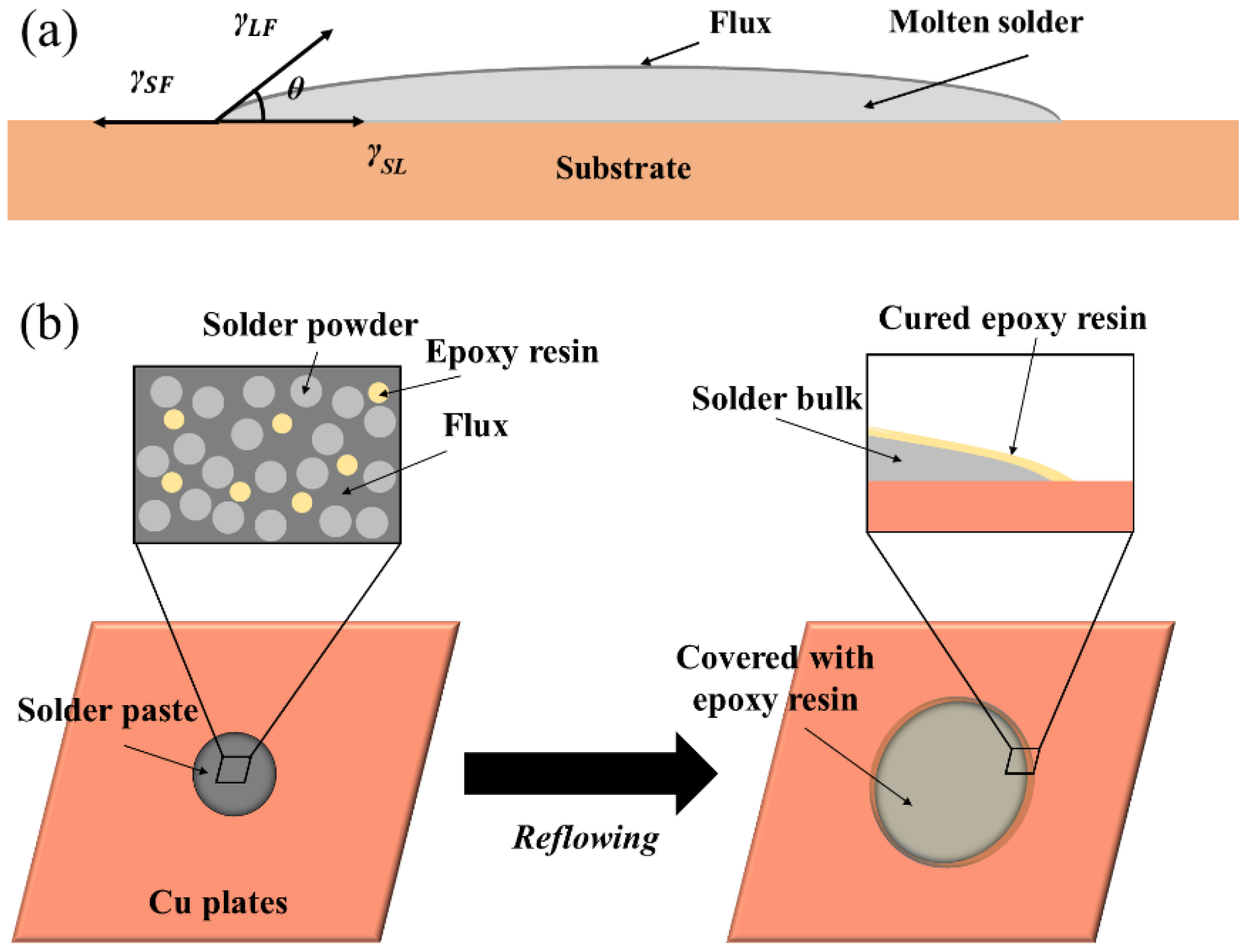
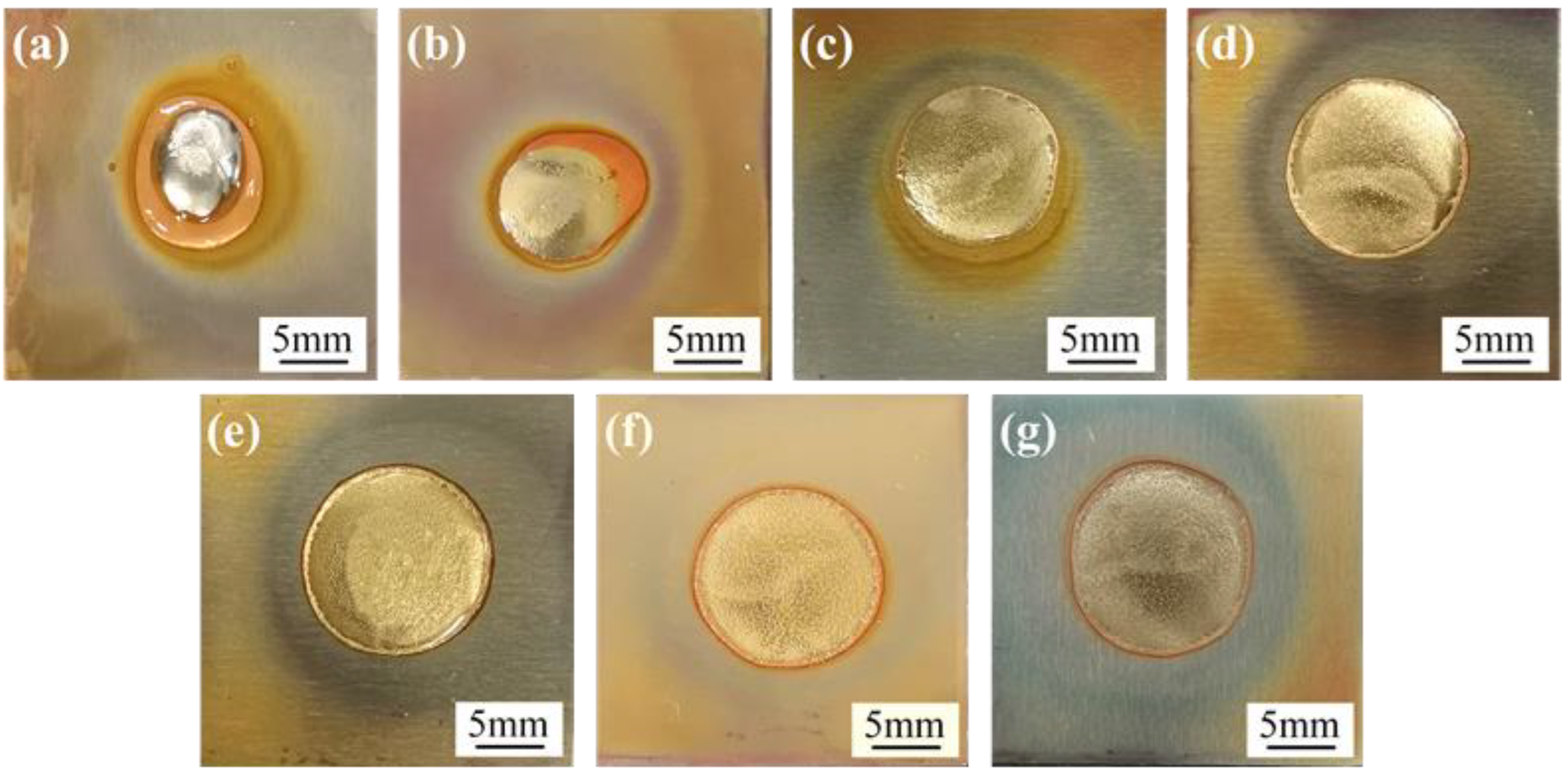


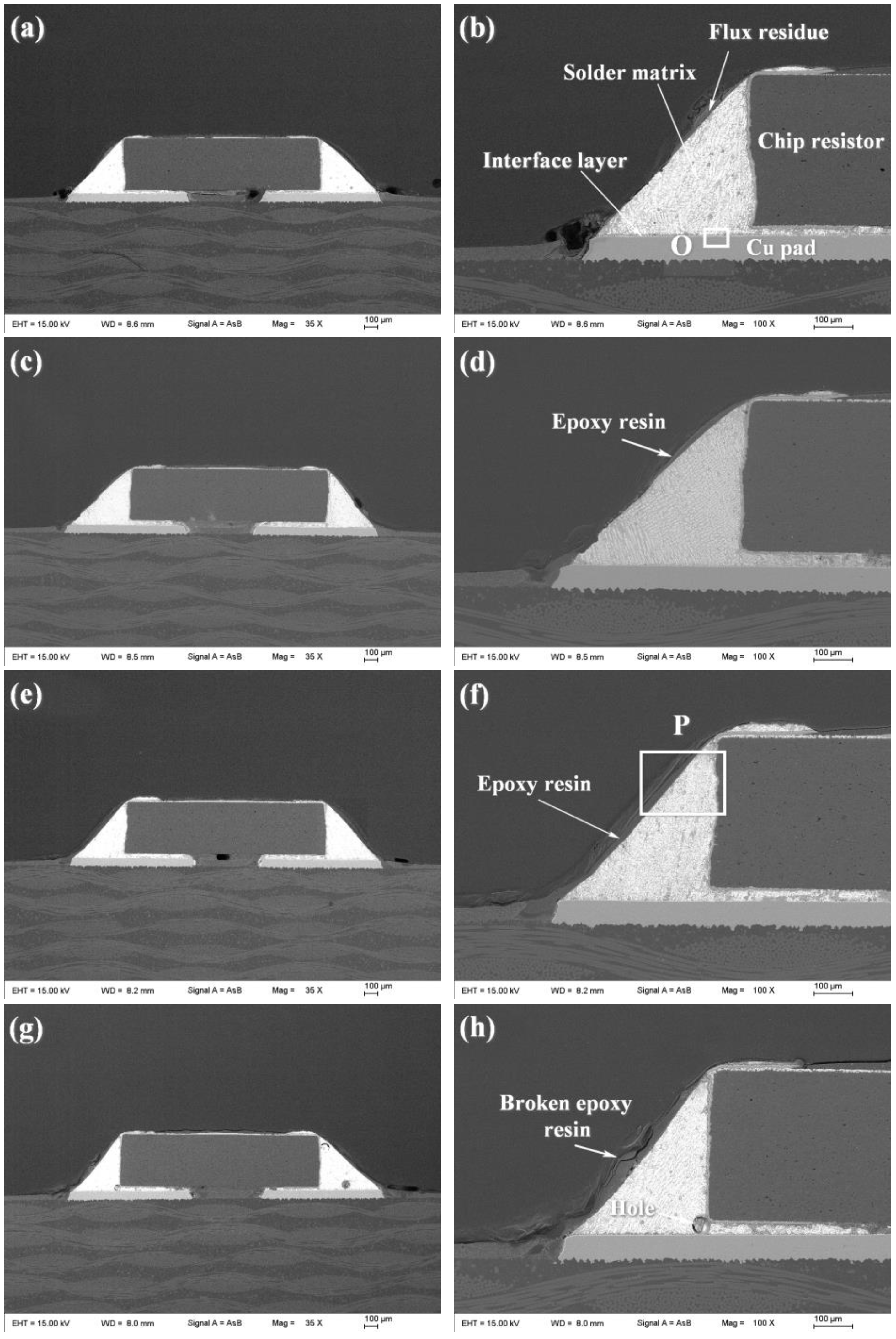
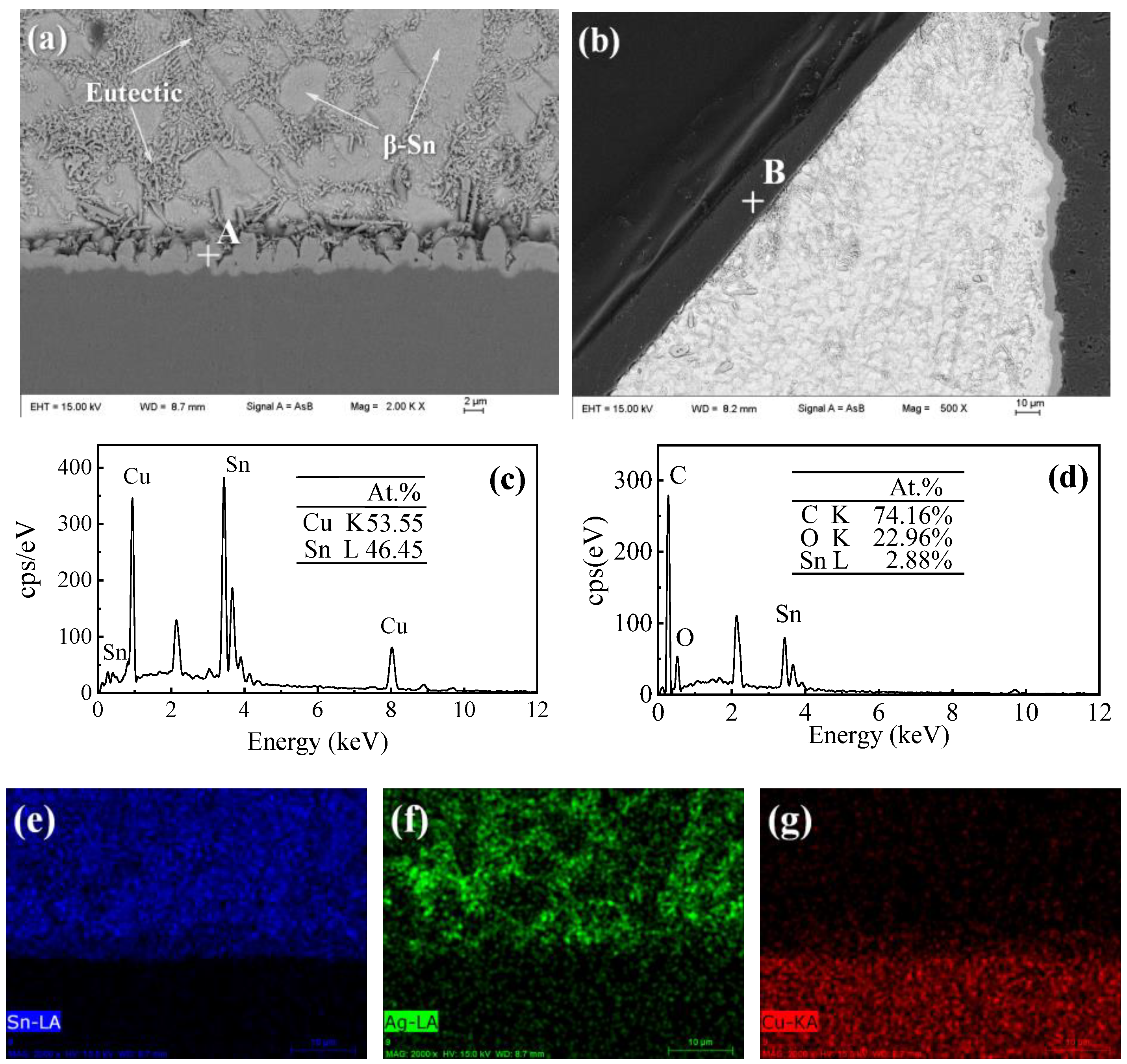

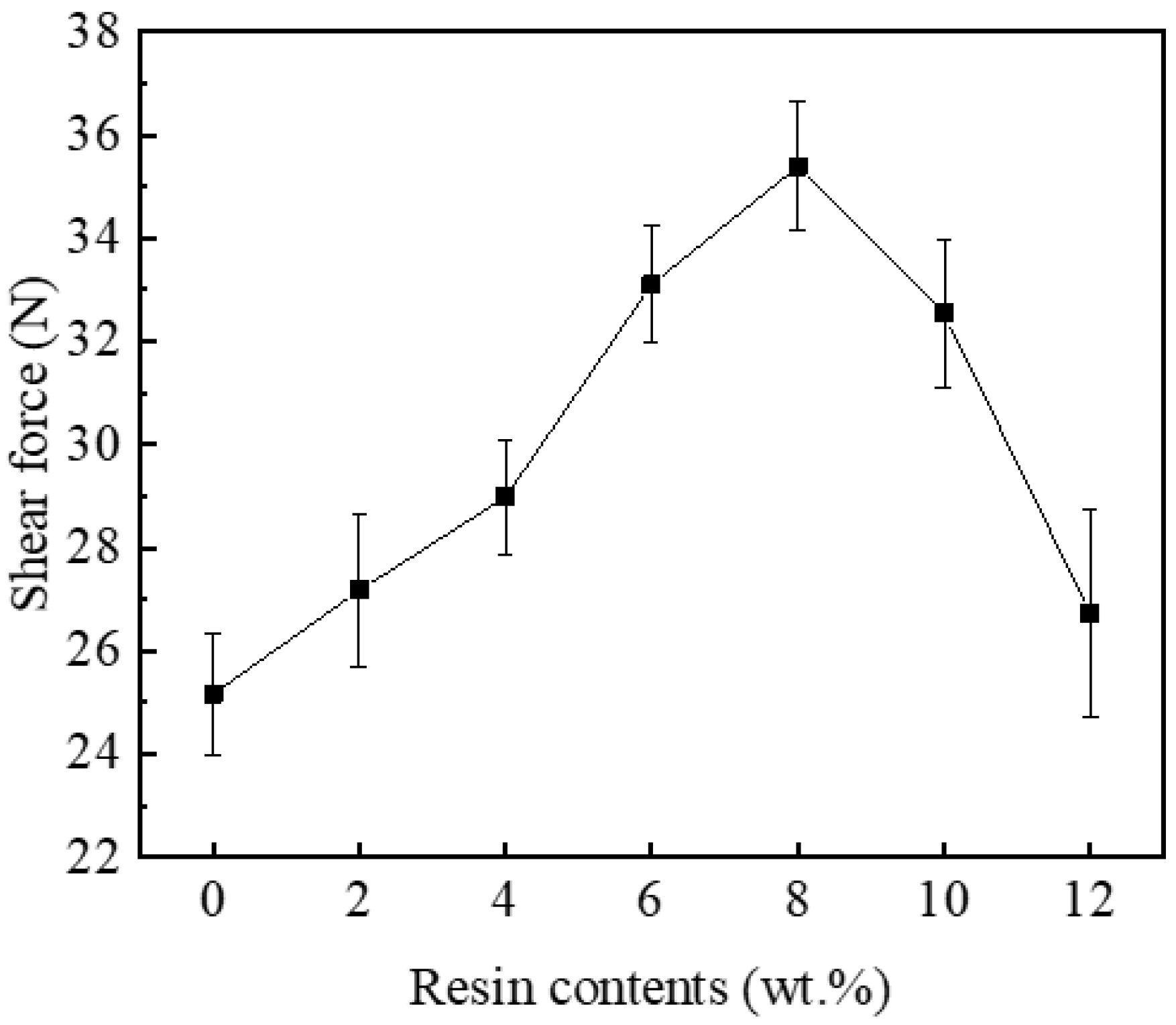

| Points | Composition (at %) | ||||
|---|---|---|---|---|---|
| C | O | Sn | Ag | Cu | |
| C | 89.34 | 10.66 | - | - | - |
| D | - | - | 93.82 | 5.41 | 0.77 |
| E | - | - | 99.24 | 0.00 | 0.76 |
| F | 83.99 | 16.01 | - | - | - |
| G | 83.03 | 16.97 | - | - | - |
| H | 82.19 | 17.81 | - | - | - |
Publisher’s Note: MDPI stays neutral with regard to jurisdictional claims in published maps and institutional affiliations. |
© 2022 by the authors. Licensee MDPI, Basel, Switzerland. This article is an open access article distributed under the terms and conditions of the Creative Commons Attribution (CC BY) license (https://creativecommons.org/licenses/by/4.0/).
Share and Cite
Zhang, P.; Xue, S.; Liu, L.; Wu, J.; Luo, Q.; Wang, J. Microstructure and Shear Behaviour of Sn-3.0Ag-0.5Cu Composite Solder Pastes Enhanced by Epoxy Resin. Polymers 2022, 14, 5303. https://doi.org/10.3390/polym14235303
Zhang P, Xue S, Liu L, Wu J, Luo Q, Wang J. Microstructure and Shear Behaviour of Sn-3.0Ag-0.5Cu Composite Solder Pastes Enhanced by Epoxy Resin. Polymers. 2022; 14(23):5303. https://doi.org/10.3390/polym14235303
Chicago/Turabian StyleZhang, Peng, Songbai Xue, Lu Liu, Jie Wu, Qingcheng Luo, and Jianhao Wang. 2022. "Microstructure and Shear Behaviour of Sn-3.0Ag-0.5Cu Composite Solder Pastes Enhanced by Epoxy Resin" Polymers 14, no. 23: 5303. https://doi.org/10.3390/polym14235303
APA StyleZhang, P., Xue, S., Liu, L., Wu, J., Luo, Q., & Wang, J. (2022). Microstructure and Shear Behaviour of Sn-3.0Ag-0.5Cu Composite Solder Pastes Enhanced by Epoxy Resin. Polymers, 14(23), 5303. https://doi.org/10.3390/polym14235303






